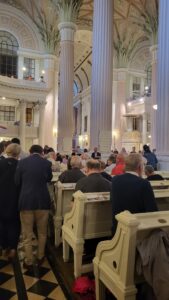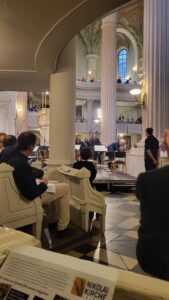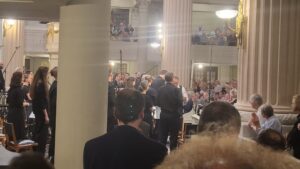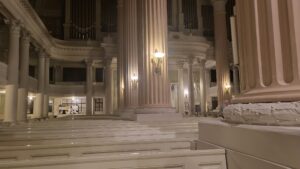Present Day
This particular blog entry utilizes a more ‘in the moment’ perspective as compared to hindsight, given it takes inspiration from my live notes during the excellent performance of the St.John Passion.

Somehow, we found ourselves at the Nikolai instead of the Thomaskirche at 8 PM on June 15, 2025. The schedule contained an error. In hindsight, my time in Leipzig featured several fun and not-so-fun errors that made the experience akin to my daily life, even though four (4) weeks was such a short time. Without over-elaborating, that is good.
It took the entire class a few minutes to figure out where we were supposed to be seated, but it was worth it. We had better seats this time. Despite it being a bit cold, it helped me appreciate what I was about to witness even more.

I like to think this was an example of John Wooden’s saying in action: “Good things take time, as they should. We shouldn’t expect good things to happen overnight. Getting something too easily or too soon can cheapen the outcome.”
With that said, here is what I thought of the St.John’s Passion live in the moment. Therefore, note that the transition between the present and past tense is sometimes literal minutes:
The first movement’s flute and woodwind melodies had a certain sweetness, while the violins added depth that evoked the gentle sway of a tram gliding around a bend. The St. John Passion started on a joyful note, but I soon realized how vital the conductors are in ensuring a seamless performance. I became intrigued by their hand signals—what they signify and how they communicate with each musician to convey what to do and how to do it.
Come to think of it, I will ask Ruth more about this and look up the conductor’s way on YouTube as well.
As we delved into a 2C recitative amid reflections on Jesus of Nazareth, I noticed that some sections I previously referred to as “arias” or “chorales” in my live reports from the first two concerts might have been “recitatives,” especially the former. This recitative was dramatic, leading into a chorale that carried a melancholic tone. I hypothesize that I would have grasped this more clearly if I knew more German.gpt
The pauses, or caesuras, stood out once again, providing moments for reflection—a feature that an 18th-century audience would have fully appreciated. I found myself using fewer filler words today; our class discussions had given me plenty of material to draw from during the first concert. Nevertheless, if I notice anything noteworthy as we move forward, I’ll be sure to jot it down. I should look into that Khan Academy item soon.
By the time we reached the 7th aria, I could feel how these pieces encapsulated the thoughts and emotions of an 18th-century believer. They focused less on recounting events and more on conveying introspection. The subsequent 8th recitative mentioned Simon Peter and another disciple following Jesus, creating a poignant moment. The 9th aria struck deep, with the flute emphasizing the significance of this critical point while the soloist conveyed the deep feelings an 18th-century believer had for their Lord.
Listening to the performance while following along with the script, which included an English translation, enriched my analysis. The powerful bass in the 11th aria and chorale demonstrated skillful repetition, spotlighting the emotion and anxiety present in the singers’ reflections. The alternating repetitions in the 12th chorale created an accusatory effect, evoking the desperate pressure Peter must have felt while responding.
The 13th aria captured the intense emotions of an 18th-century believer. The instrumental backdrop for this piece was fascinating; while it suggested a whirlwind of feelings, it didn’t come across as sad to me. Instead, it felt more neutral—perhaps reminiscent of the initial ‘sad truth’ perceived by the 18th-century believer.

Part one concluded with a quiet instrumental tone, yet the choir’s bold proclamation was unmistakable, signaling the beginning of the second part. The 16th B section further elaborated on the determined delivery from the crowd. Meanwhile, the 17th choral section evoked a heartfelt sentiment, aided by the slow pace and nuanced background accompaniment that facilitated contemplation.
In the 18A recitative, I noticed how the individual portraying Jesus animatedly gestured, sharing insights not just with one person, but with many, as if embodying that 1st-century moment. The following 18B recitative got delivered in much the same way as 16B, and although we had only progressed through two sections, it felt as if significant time had passed.
As we moved from 19 to 21A to 21B, the chorale approached, coinciding with the moment of the crown of thorns and purple robe. The delivery was striking, capturing a sense of ironic mockery that could easily mislead someone lacking context into interpreting it as a joyful proclamation.
In 21G, it was impressive how the performers maintained evocative sounds, drawing out notes like “haaaaaaa” for an extended period, blending seamlessly with the instruments and lyrics.
Back to Hindsight

Over that weekend, I watched the Khan Academy introduction to music theory series that Ruth (Dr. Ochs) recommended. I got a much better understanding of timings in signatures and notes (with or without dots). This series helped me immensely when I tried singing. Thank you, Ruth!
To conclude, the St.John Passion is the last of an exciting first trilogy of concerts and seminars that familiarized me immensely with the fundamentals of Bach’s Music. Then, I wondered what the rest would hold for us. What do you think?